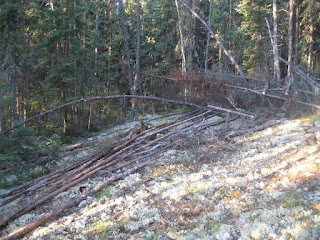Not a promising start to the day, but a very lovely sunrise. It did rain lightly a few times during the day but no significant downfall.
As soon as I made the 250 metre portage, seeing the blockade of cattails and knowing I had to canoe upstream, I felled and trimmed a three metre long birch tree in order to pole the canoe.
At each "beaver creek" I travelled, I kept thinking it cannot get worse ... but it did. The long birch pole was used to good advantage, most often poling on the sides of this creek in the grass and cattails. By the time I reached the end of this one km section of the creek, it seemed I had travelled twice that far because of its looping twisty nature, sometimes heading back in the direction from which I came. This creek was more difficult because I was moving upstream. Lots of poling, paddling, wading, pushing, pulling, lifting, lining, towing. I never thought I would think it, but as I battled on, I actually spoke out loud "Portaging is easier than this. Aie!"
The 200 metre portage on this winter trapline trail needed very little clearing. I was glad to make a small smoky fire to shoo blackflies away while I rested and had my lunch.
Next was a 500 metre section of the narrow creek. I made my way as far as I could go without putting on my wading gear. Then I walked into the bush to see about a trail. Right away I found the trapline trail and walked on it to where the trail ended in very wet marsh, still quite a way from the target lake which I could see in the distance. There was no way to launch the canoe here as it was too shallow and choked with grass and willows. The trapper has the advantage in winter of being able to traverse the frozen marsh with his snowmobile. Where I had parked the canoe in the creek was not suitable to start a portage, so I had to push the canoe back with the pole about 50 metres to where I had identified a good place to access the trapline trail. After I unloaded the gear and canoe on land, I cleared the 310 portage trail, including cutting the lower most 20 metres to rejoin the creek. I blazed a spruce tree at each end of my portage where it joined the trapline trail so I could easily identify it when carrying heavy loads. It is easy to lose the trail and head off into the bush, especially frustrating if carrying the canoe and now in a dead end from which you have to back out if possible or set the canoe down and pull it back.
I had a short distance to canoe up the creek inlet but still needed the pole and had to cross more small beaver dams. Dams like these I was sometimes able to pole the canoe over, but often I had to paddle or pole as far across as I could, then stand on the dam and pull, lift, push the canoe across. If careful, I was able to keep my feet relatively dry, with water only up to the top of the foot portion of the boot. Thank goodness for Gore-Tex™ construction in the boot.
Blackflies were quite bothersome, hence my "hat scarf".
I said goodbye to my trusty birch pole. I could not bear to just discard it in the water, so I canoed to shore and stood it up in a tree. Perhaps I would need it again.
Camp 31, after travelling six km, including three portages totalling 760 metres and 1-1/2 km of "beaver creek" with at least nine beaver dams. After I have identified that a site is suitable for camping, I unload the canoe, haul the canoe on shore to a safe place and under it stash the gear that is usually left there. I haul the required gear to the fire site and to the tent site. The tent site has to be cleared and levelled, the tent erected and sleep gear laid out inside the tent to air. Some gear is stowed in the front and rear tent vestibules. Then I build a rock fireplace on a fire-safe surface which often has to be cleared first, unless I can dig a fire pit. A tarp shelter is put up and gear stowed under it. (At bedtime, most of this gear is stowed in the tent proper or in the tent vestibules.) In the above photo, because the weather was good, I made and ate supper before putting up the tarp. I was hungry and weary! The bug tent was required because the mosquitoes were quite bothersome. It is so nice to be able to relax away from bugs at mealtime. If the blackflies are bothersome I may make a fireplace first thing and start a smoky fire to shoo them away.































